Affiliate disclosure: This post may contain affiliate links. Please see our Privacy Policy.
Canning meals in a jar is a great way to have delicious homemade prepared food ready to heat and eat, all right from your pantry shelf.
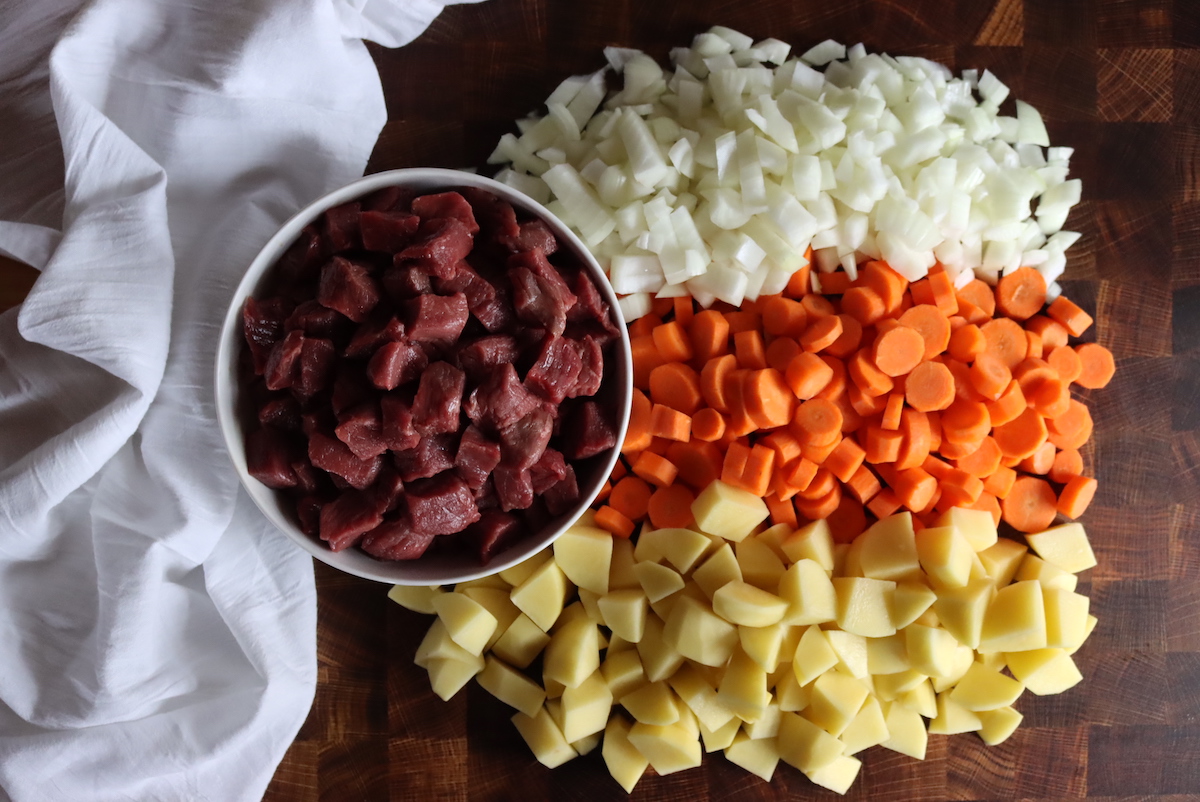
It’s one thing to use canning to put up a little bit of extra produce from the garden, but you’ve reached a new level when you start canning ready-to-heat and eat meals in a mason jar.
You’re not canning ingredients anymore; you’re canning whole meals that will make a real difference on a busy weeknight later on.
While it’s true that a jar of homemade beef stew isn’t quite as versatile as individual jars of home-canned potatoes, canned carrots, beef stock, and stew beef…it makes more sense when it’s late, and you’re flailing around looking for meal ideas.
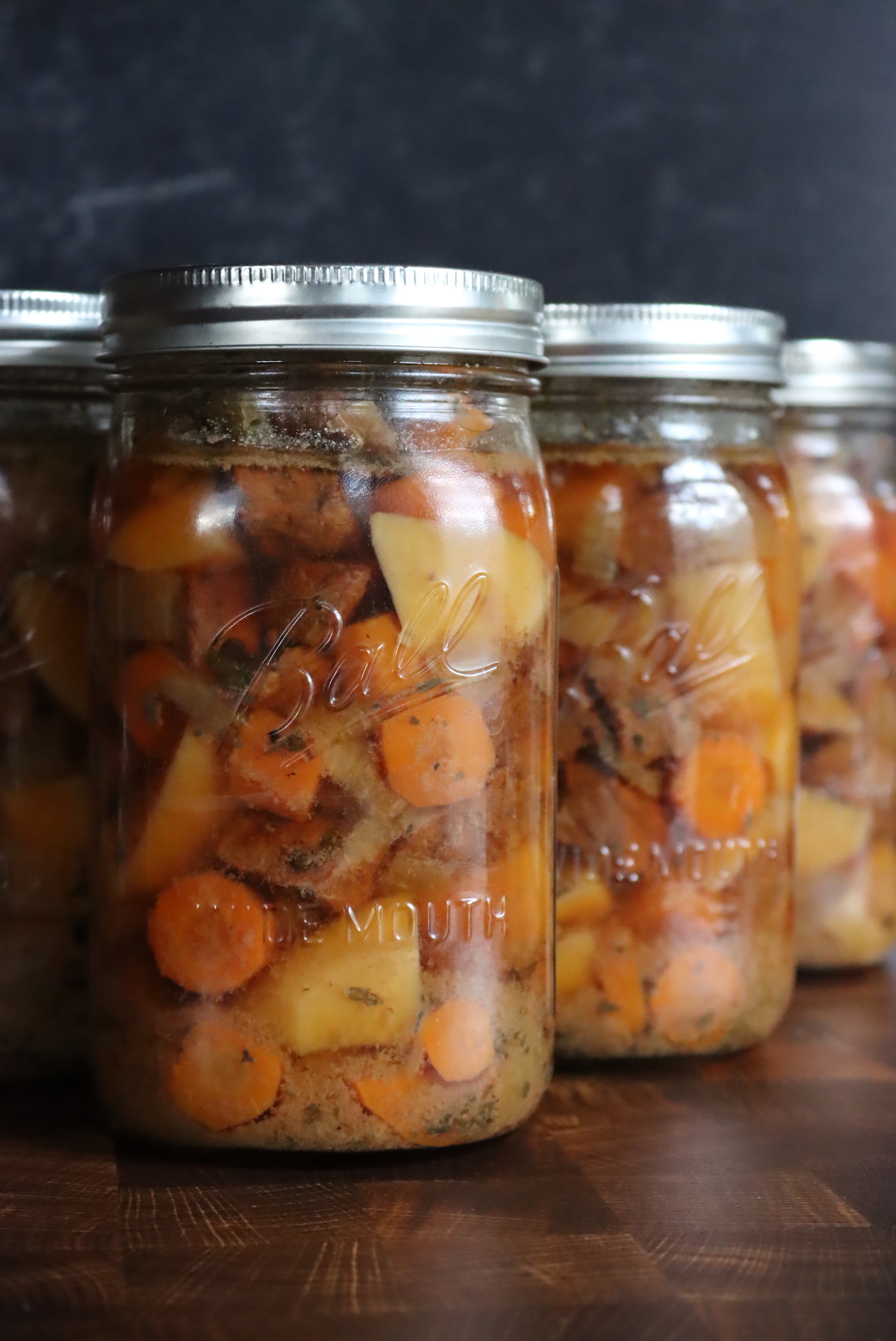
Just a few home-canned meals in a jar can mean the difference between a satisfying, healthy home-cooked meal instead of expensive, greasy take-out food.
Versatility comes from canning a variety of different ready-made meals that you know your family loves. To do that, you need a good selection of meal-in-a-jar canning recipes.
Fear not, I’ve got you covered!
I’ve rounded up every tested, publicly available meal-in-a-jar recipe I could find online, and I’ll keep adding as I find more.
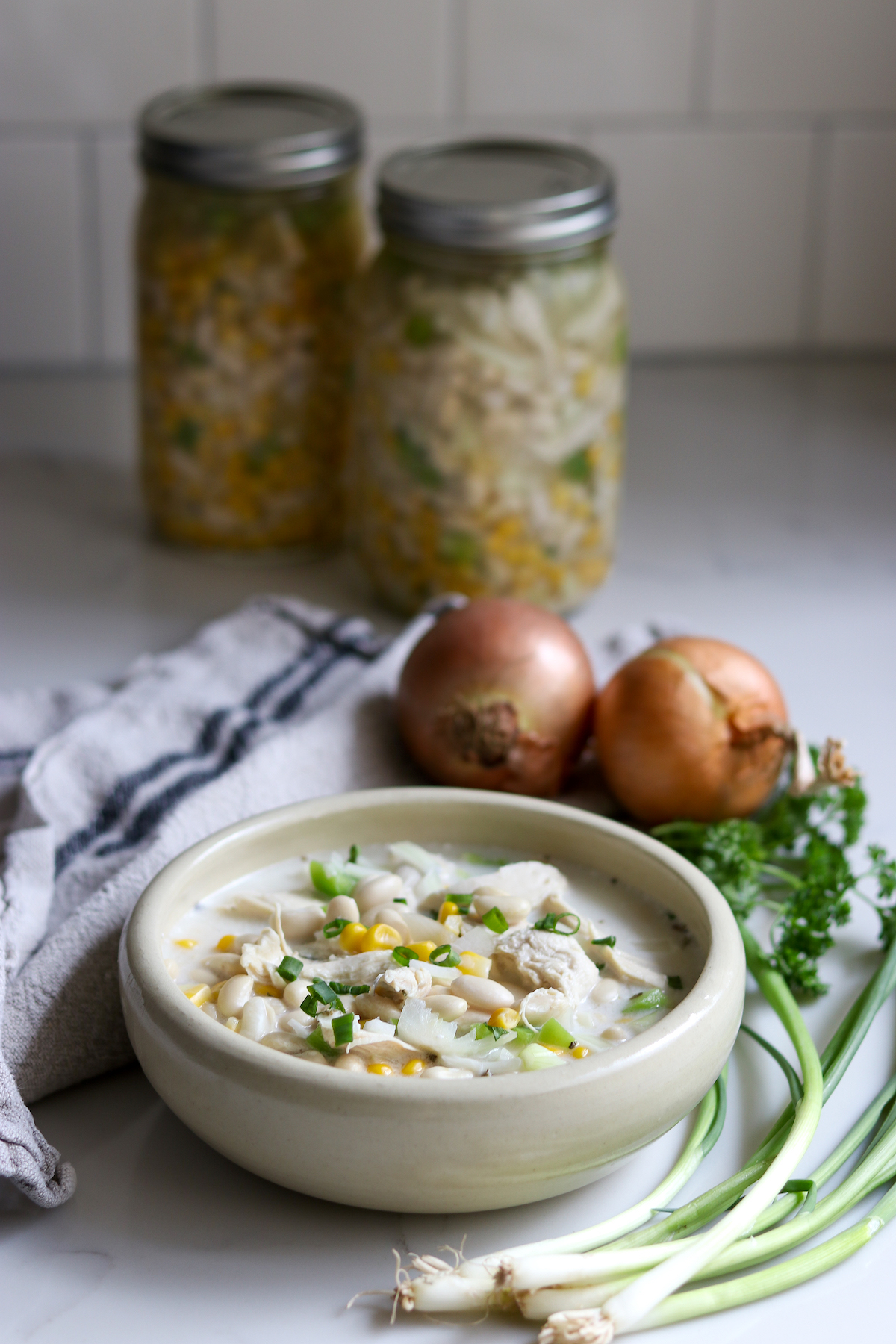
Guidelines for Canning Meals in a Jar
Before we dive into the actual recipes, it’s important to cover what’s safe for canning (and what’s not).
All of these recipes are pressure-canning recipes because they include hearty ingredients like meat and vegetables. Canning jam, fruit, and pickles in a water bath canner does preserve food, but it just provides condiments and dessert, not the heart of the meal.
If you’re not familiar with pressure canning, please read my beginner’s guide to pressure canning before you get started.
I use a 30-quart All-American Brand Pressure Canner, and it’s the best one on the market, in my opinion. There are other options though, and I cover all of those in my article on the supplies you need for canning.
Once you’re familiar with how a pressure canner works, realizing it has its limits is important. While it’s perfectly fine to can meat, broth, and vegetables, some ingredients cannot be canned at home.
Canning recipes should never include:
- Milk, Cream, Butter, and Other Dairy Products
- Coconut Milk
- Flour, Corn Starch, and most thickeners
- Rice, Pasta, and Other Starchy Foods
- Eggs, including pickled eggs
For meals/soups, skip all thickeners in the jar. Cook-type Clear Jel is used in specific tested pie filling recipes (like this apple pie filling canning recipe), but it’s not part of the standard guidance for savory meal jars.
All of those ingredients can be added at serving time. For example, we pressure can beef stew without thickeners and then quickly thicken the broth as we’re warming it on the stove.
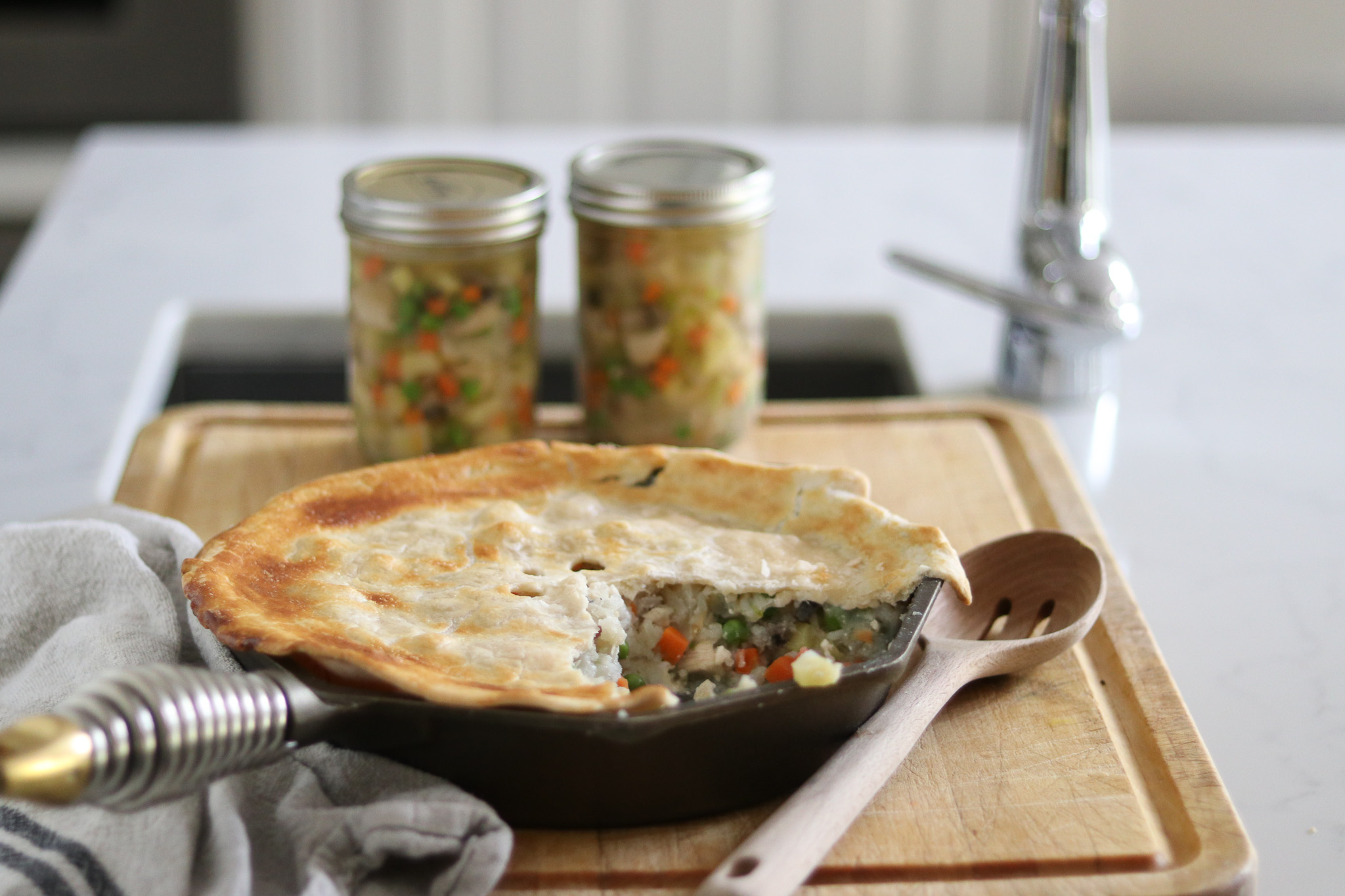
The only thickener safe for canning is cook-type clear jel, which is usually used when canning premade pie fillings. Some people do use it to thicken sauces in savory meals, but I don’t. It leads to a goopy, pie-filling-like texture that I don’t want in my main courses.
Pasta for chicken noodle soup is another example. Just can the chicken, broth, and veggies, then cook the pasta and add it in as the soup warms on the stove.
You can pressure can things like Thai curry, but you’ll have to add coconut milk when you warm the meal.
You get the idea.
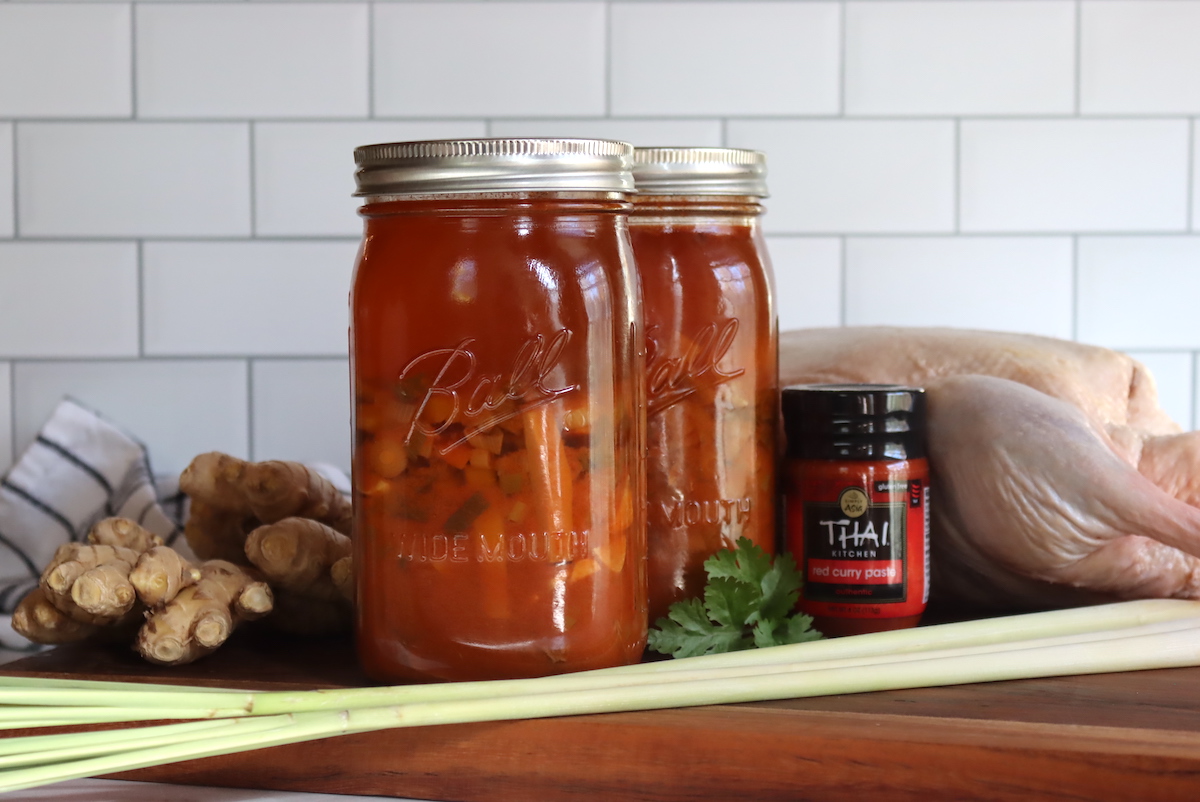
If you’re worried about not having perishable ingredients like milk and butter on hand when it comes to mealtime, there are shelf-stable versions of perishable pantry ingredients that require no refrigeration.
They’re a great option to keep in your emergency pantry, right next to your meals in a jar.
Lastly, I’ll note that if you’re above 1,000 feet in elevation, you’ll need to adjust the pressure accordingly to make sure your meal-in-a-jar recipes are processed correctly. You can refer to this guide on altitude adjustments for pressure canning.
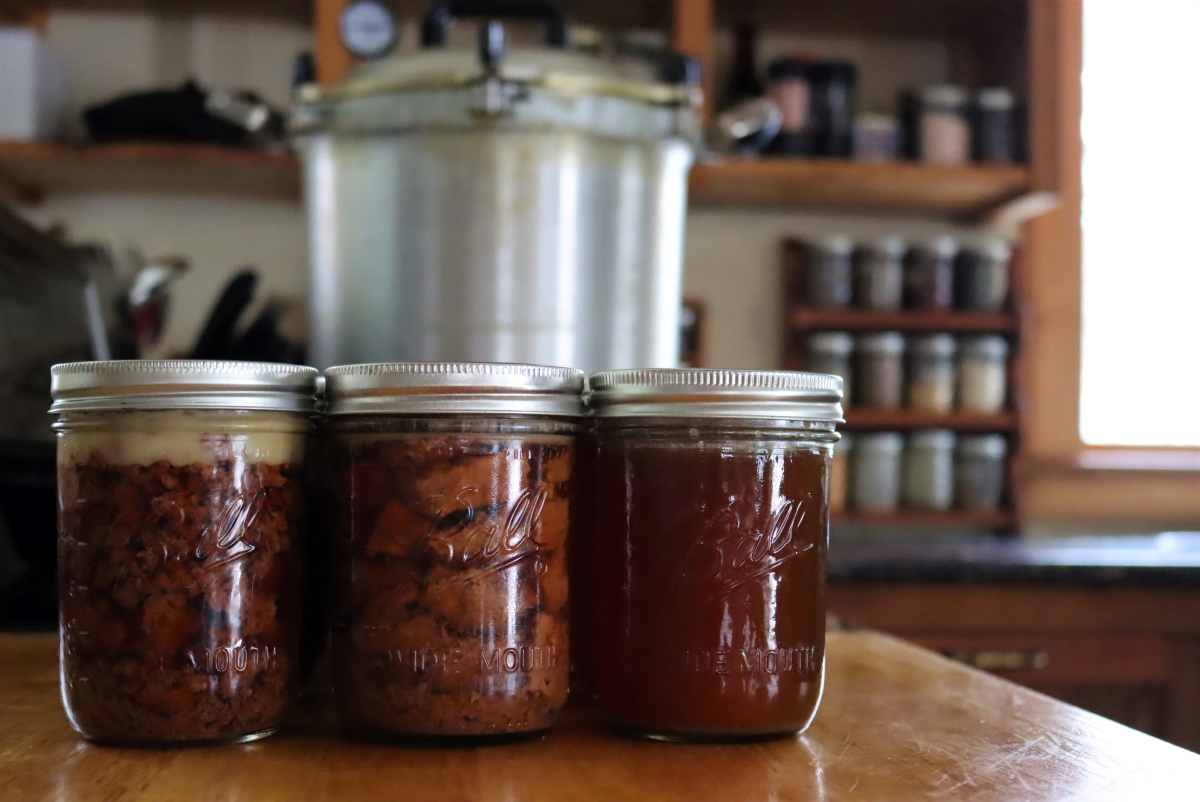
Meal in a Jar Canning Recipes
I’ve scoured the internet for every meal-in-a-jar canning recipe available and collected them all into categories for your easy reference. Hearty meals like chili, soups, stews, curries, stroganoff, and more.
That said, not every pressure canning recipe is available free on the internet at this point. There are plenty more, but you’ll have to look in canning books.
In my opinion, the best pressure canning book is Pressure Canning for Beginners and Beyond by Angi Schneider. It contains some truly spectacular (and unique) meal-in-a-jar recipes that you just can’t find anywhere else.
I love that Angi’s recipes are all well-tested, and she’s put in extra work to ensure they’re all safe and approved for home canning. She has several dozen meal-in-a-jar canning recipes that are not published anywhere on the internet.
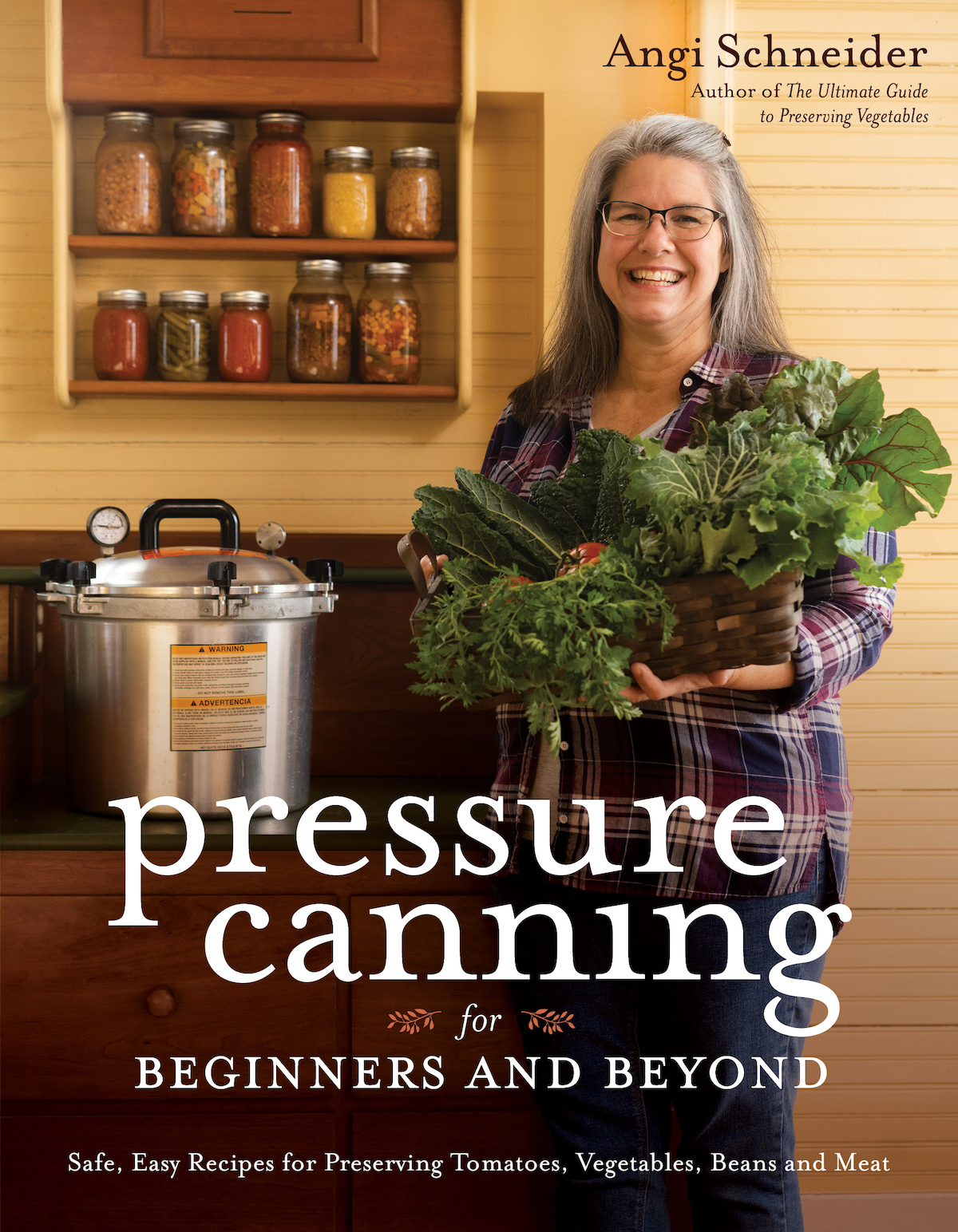
The other book I’d recommend is The Complete Guide to Pressure Canning by Diane Devereaux, but if you use that book, you’ll have to do your own homework. She includes some ingredients that are just not safe for pressure canning (like coconut milk, etc.), so be sure to watch that.
She also uses clear jel as a thickener in soups, which, while approved for canning, makes them goopy and is not to everyone’s taste.
Nonetheless, she has many good ideas, and her book is a great place to get inspiration. If you only get one pressure canning book, go with Angi’s Pressure Canning for Beginners and Beyond.

Hearty Meat Dinners
Hearty dinners made from canned seasoned meat work out really well at the center of the table. Some of these are just the meat main course, meaning you can add something like home-canned corn on the side. Or, you can just heat and eat and not worry about it.
Others include everything, with both meat and vegetables in the jar.
Either way, I’ve broken them down by the type of meat included in the recipe. If you’re looking for vegetarian main courses, skip down to the next section.
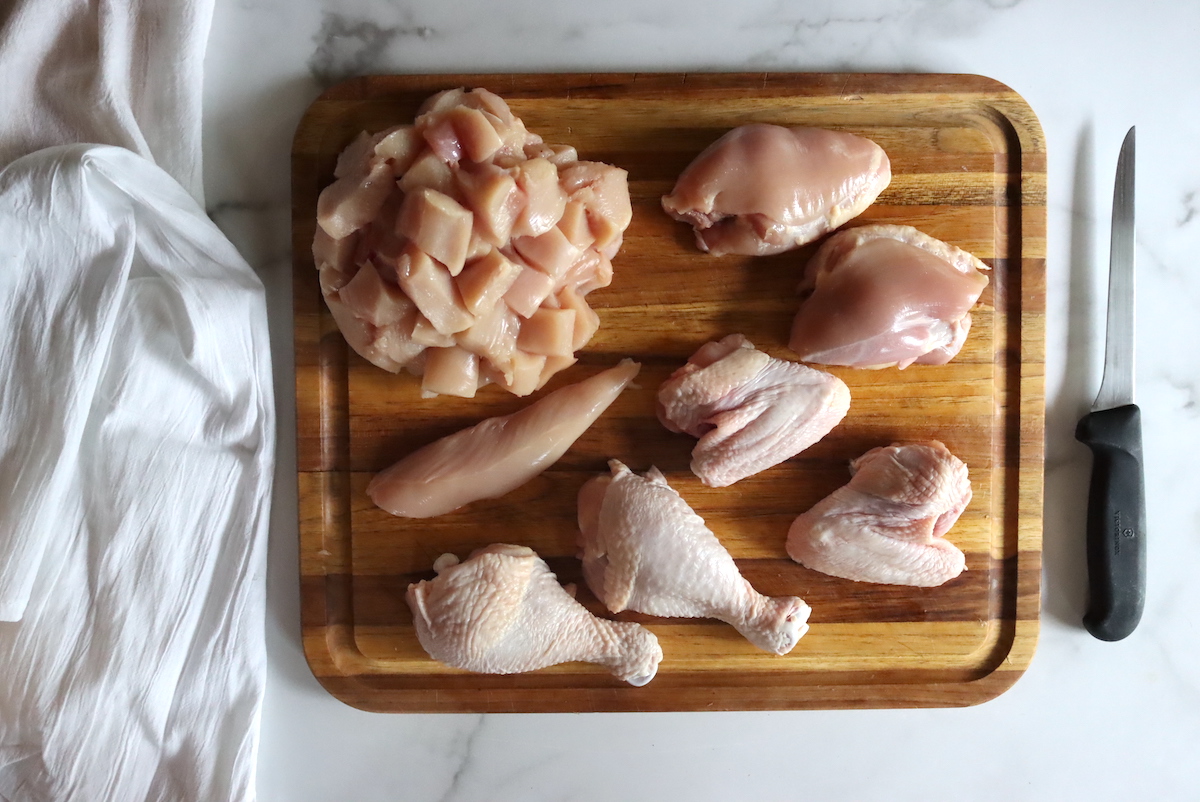
Beef
These beef meal-in-a-jar canning recipes will also work with other types of red meat, including venison, moose, bear, and veal. Pork can also be substituted in place of beef in any of these recipes, as the canning instructions are the same.
Canning beef generally can be done as slices, steaks, cubes, or ground meat, and is usually done with beef stock as the canning liquid (but tomato juice is also popular).
I have a separate list of more than 30 beef canning recipes, but these are a great place to start:
- Beef Pot Pie Filling
- Beef with Wine Sauce
- Beef Burgundy (Julia Child’s Recipe)
- Beef Pot Roast in a Jar
- Beef Stroganoff
- Beef Tips and Gravy
- Sauerbraten
- Meatballs in Tomato Juice
- Chipotle Beef for Tacos
- Vindaloo Curry (Often done with lamb or goat, but beef works well too)
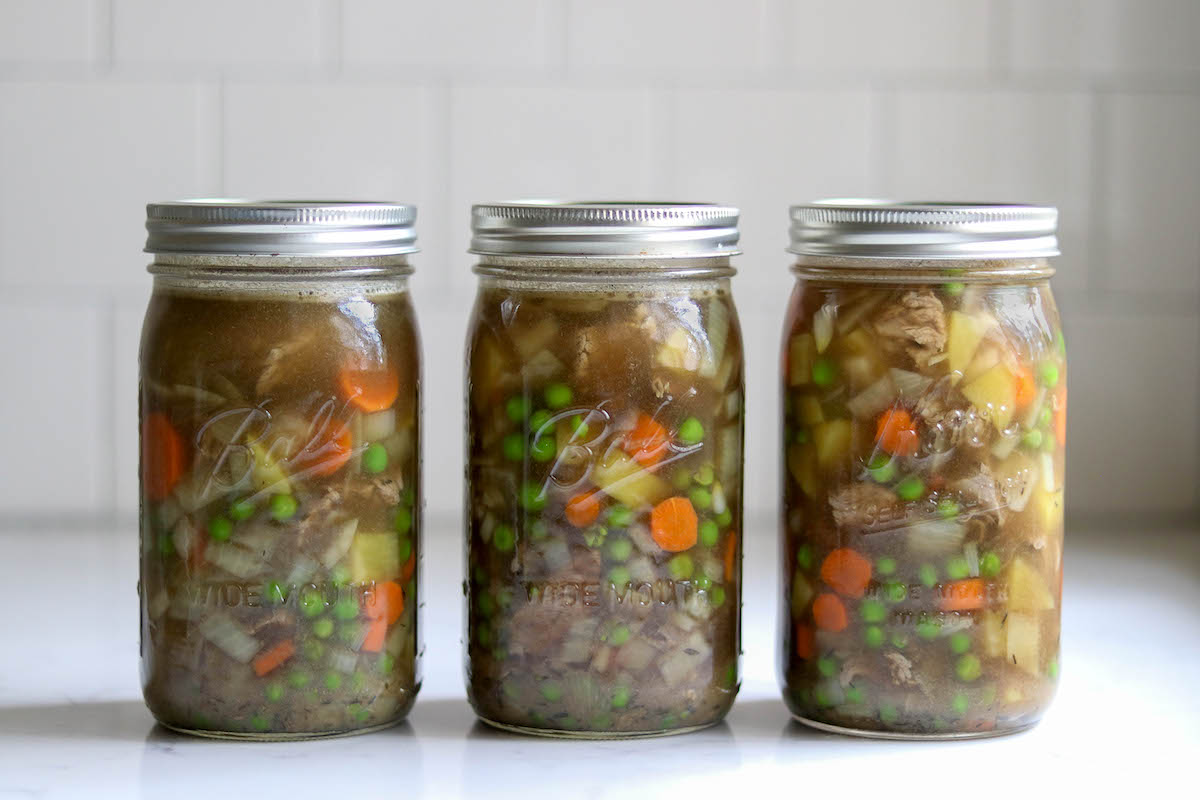
Beyond whole chunks of beef, you can also pressure can ground beef. Ground beef canning recipes are an economical way to put protein on your pantry shelf, and it works especially well for canning taco filling, chili and sloppy joe filling.
You can also can plain ground beef; believe it or not, canning Hamberger patties work fine too. Once out of the jar, you just brown them again to crisp the outsides and serve them like a regular hamburger.
- Canning Hamburger (patties or crumble)
- Taco Meat (Ground beef and seasoning)
- Ground Beef Chili (Chili con Carne)
- Sloppy Joe Filling
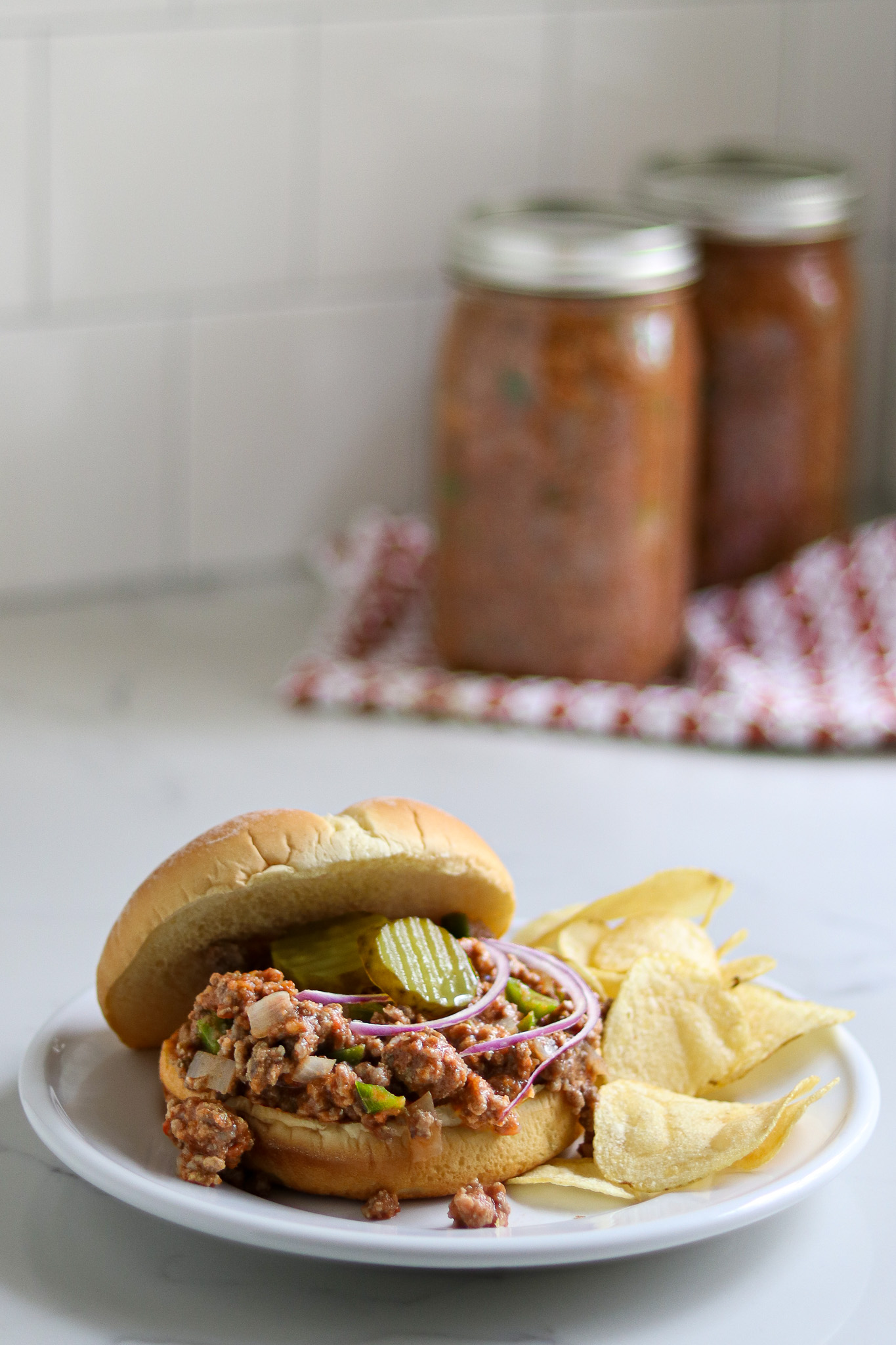
Pork
The instructions for canning pork are largely the same as canning beef, and it can also be put up as slices, steaks, cubes, or ground.
The main thing to note here is that cured pork products (like ham and bacon) are not approved for canning because the cure makes the meat denser, and heat doesn’t penetrate the same way.
There are a few tested canning recipes that use a small amount of ham or bacon for flavor, like Boston Baked Beans. Those have been specifically tested, and it’s really only a piece or two per jar.
You cannot put up a whole jar of bacon or ham alone, as there’s no tested process for that.
- Pulled Pork
- Pork Tenderloin
- Pork Sausage
- Quebec Pork Meatballs
- Pork Spareribs
- Mississippi Pork Roast
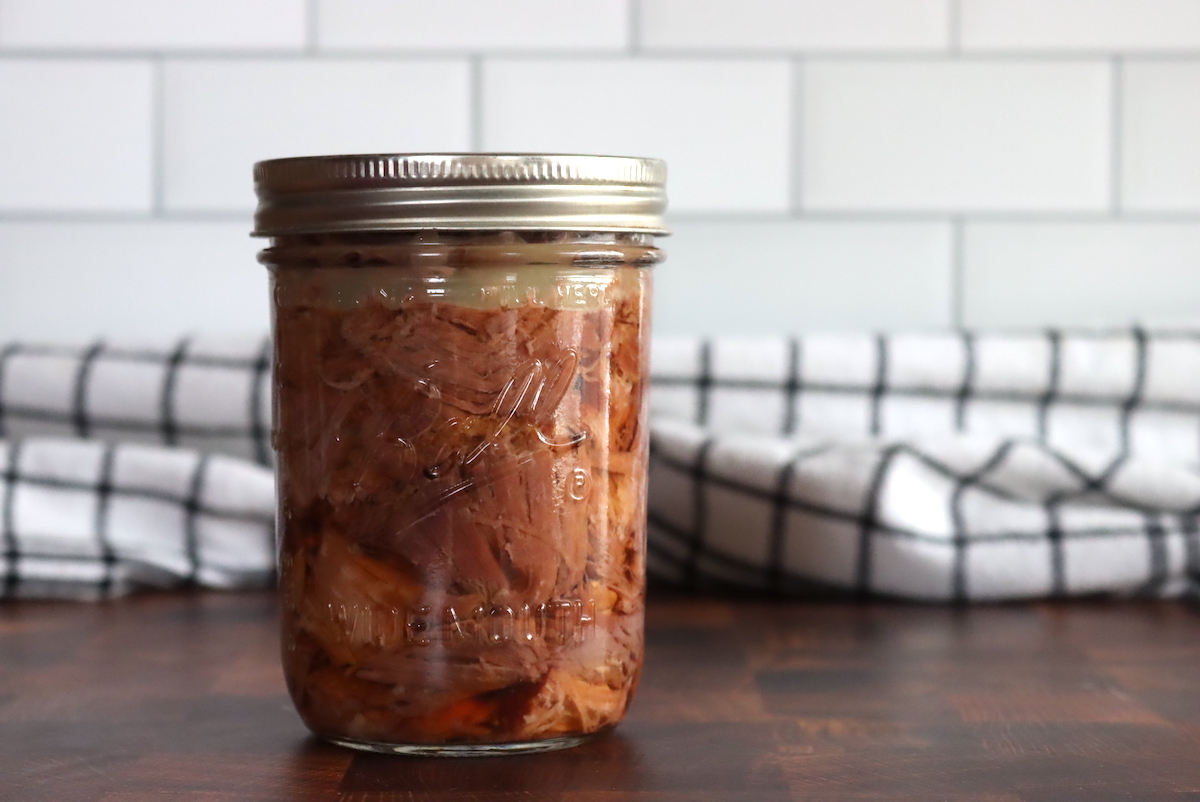
Chicken, Duck & Rabbit
The canning instructions for chicken, duck, and rabbit are all the same. (The same instructions apply to goose, partridge, and other game birds, as well as small game like squirrel.)
Poultry can be canned bone-in, or boneless, and believe it or not, when you do it, bone in the canning time is less because the bones conduct heat to the center of the jar better.
They also take up space in the jars, so you lose a bit there…but it is still not a bad option for pieces that are hard to bone raw (like wings and legs).
I have a separate list of more than 20 chicken canning recipes, but here are a few to get you started.
- Canning Chicken: Breasts, Thighs, Drumsticks or Wings
- Chicken and Gravy Dinner in a Jar
- Chicken Pot Pie Filling
- Chicken Soup
- Chicken Marsala
- Chicken and Mushrooms in Garlic Sauce
- Chicken Curry
- Chicken Taco Meat
- Thai Red Curry Duck (or Chicken)
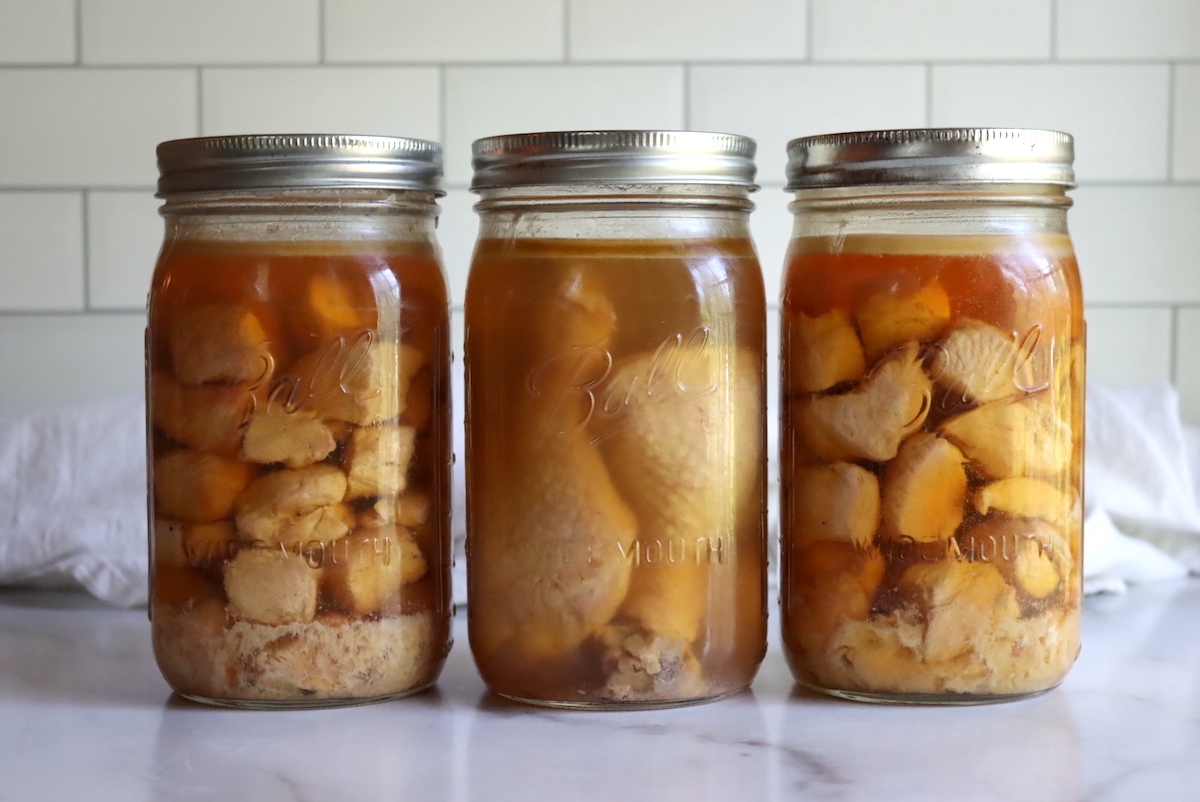
Vegetarian Meal in a Jar Canning Recipes
If you’re looking for meal-in-a-jar canning recipes without meat, you’ve come to the right place. While most feature some type of meat front and center, there are quite a few that are based on either beans or mixed vegetables.
Things like soups, chili, veggie baked beans, and more.
- Beans with Tomato or Molasses Sauce (Vegetarian)
- Vegetarian Chili Beans
- Spiced Tomato Soup
- Garden Vegetable Soup
- Canning Mushroom Soup Base (Cream/Thickener added at serving)
- Potato Leek Soup
- Carrot and Fennel Soup
- Asparagus Soup
- Spicy Tomato Vegetable Soup
- Tomato Soup Concentrate
- Canning Beans (Pinto, Black, and more)
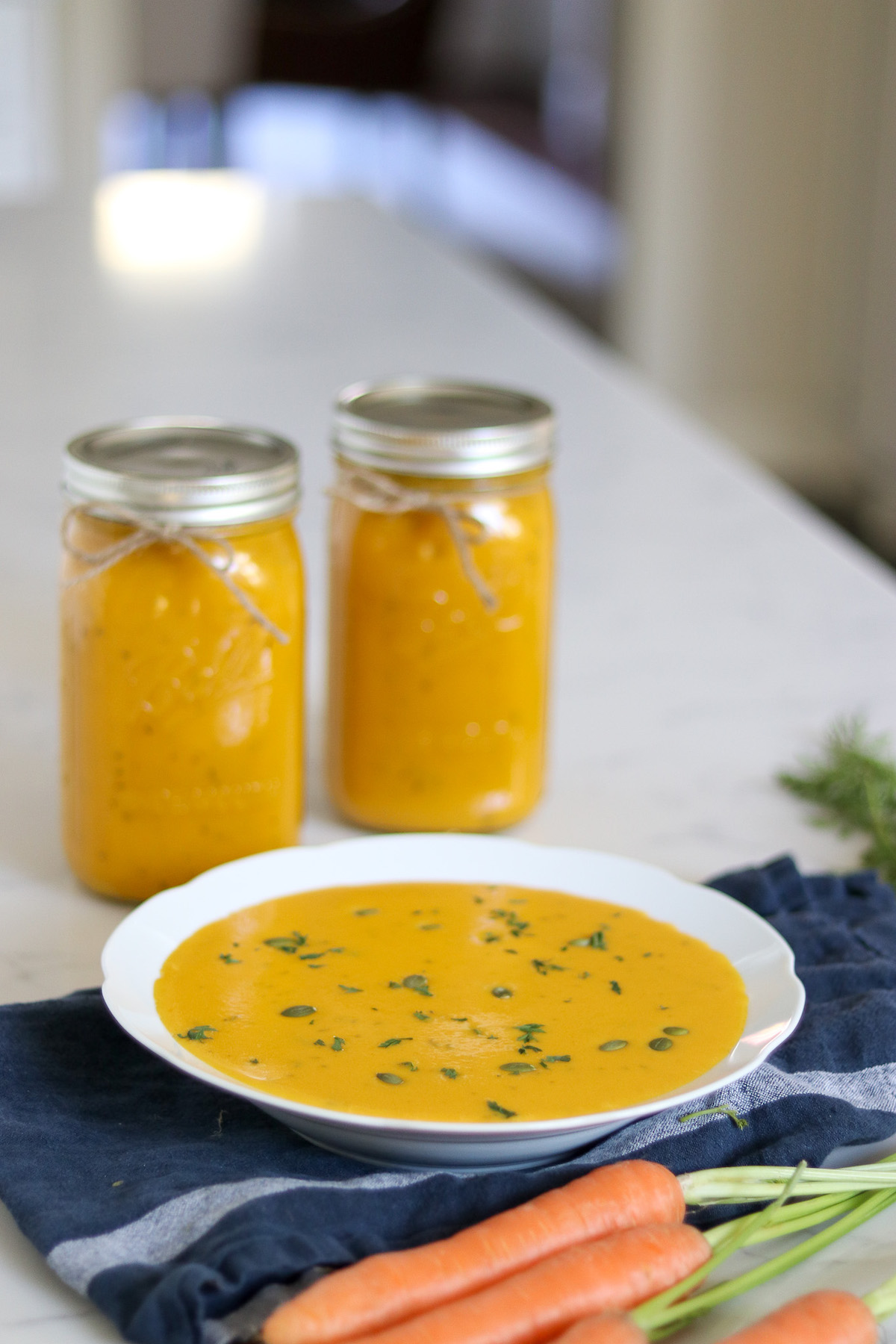
Chili Canning Recipes
A classic easy meal in a jar, chili has all the ingredients to satisfy right in one bowl. Standard chili con carne is always a classic, but you can also make mixed bean chili or a lighter white bean and chicken chili too.
We always keep a few different variations on our pantry shelf, and then it’s easy to serve next to a quick batch of homemade cornbread.
Beef Chili Canning Recipes
While these are beef chili recipes, you can substitute any red meat instead of beef.
Feel free to turn this into venison chili, elk chili, or even bear chili if you have the meat.
- Classic Chili con Carne (Ground Beef Chili With Beans)
- Meat Lovers Chili
- Chipotle Ground Beef Chili (no beans)
- Beef Chuck Chili (no beans)
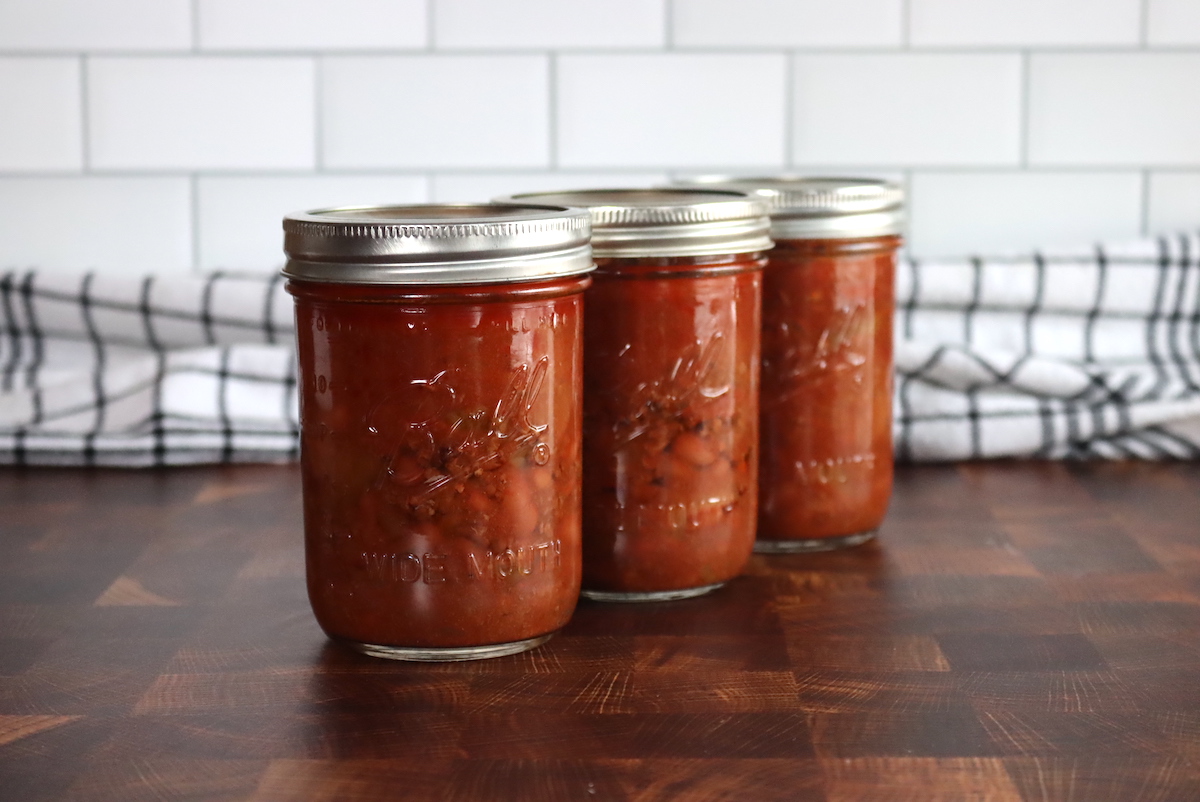
Chicken Chili Canning Recipes
Red meats make traditional chili recipes, but chicken chili is delicious in its own right. These chicken chilis tend to keep things lighter, skipping the tomato and using white beans instead of red kidney beans.
They’re a nice twist on an old classic.
(You can use any poultry in these recipes, including turkey, duck, or goose.)
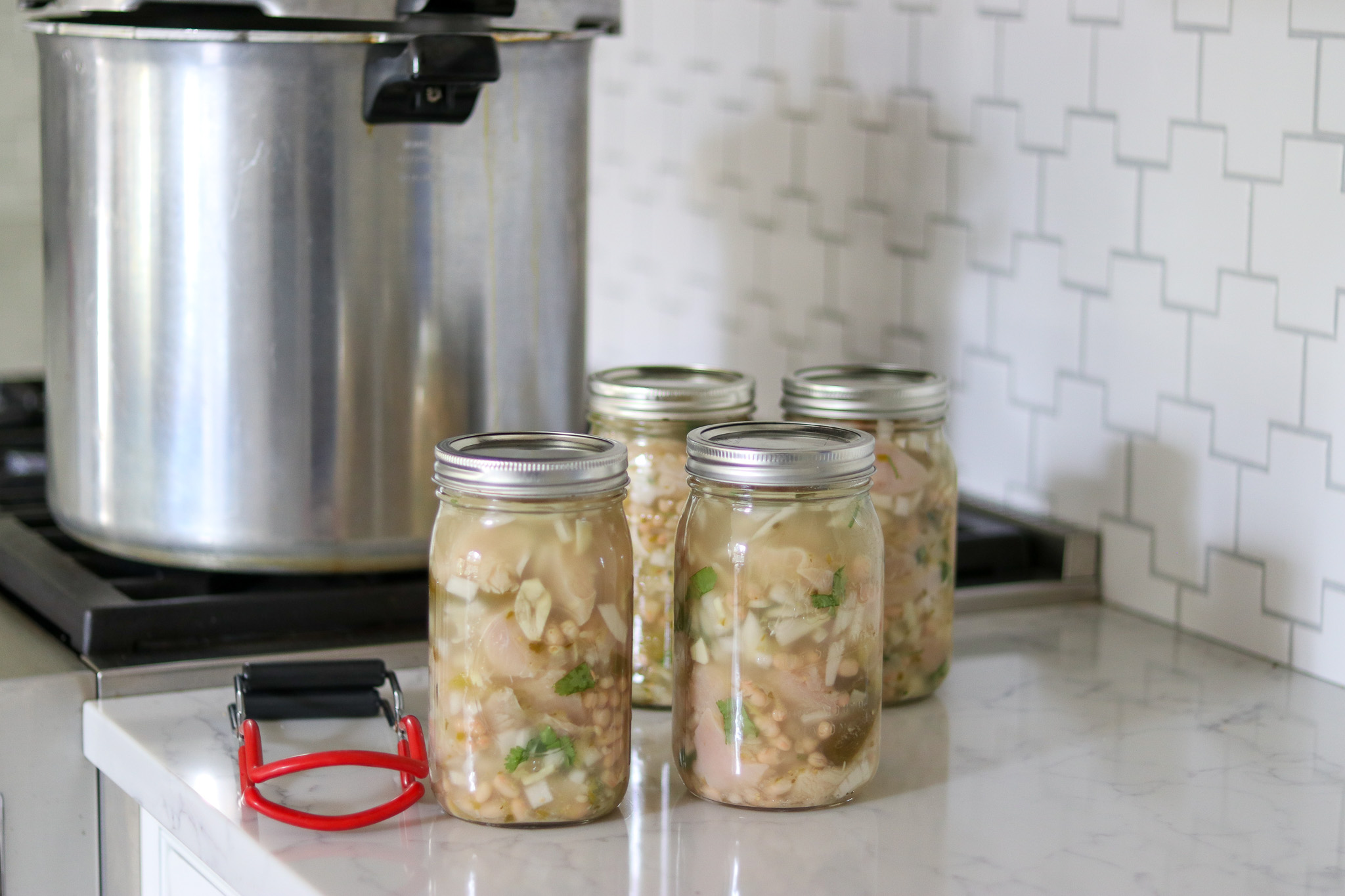
Other Chili Canning Recipes
While pork and venison can be used in place of beef in classic beef chili recipes, sometimes it’s nice to have a specific recipe that tailors the seasonings to the meat used.
Meat and Bean Canning Recipes
Chili isn’t the only way to put meat and beans in a jar.
Honestly, most chili recipes don’t even include beans…they’re just spiced meat. Anyway, meat and beans are a classic combination that deserves their own category.
While baked beans are popular, it’s far from the only option for meat and bean canning recipes.
- Cajun Red Beans with Andouille Sausage
- Beans with Salt Pork and Tomato Sauce
- Chili Con Carne (Ground Beef Chili with Beans)
- Boston Baked Beans
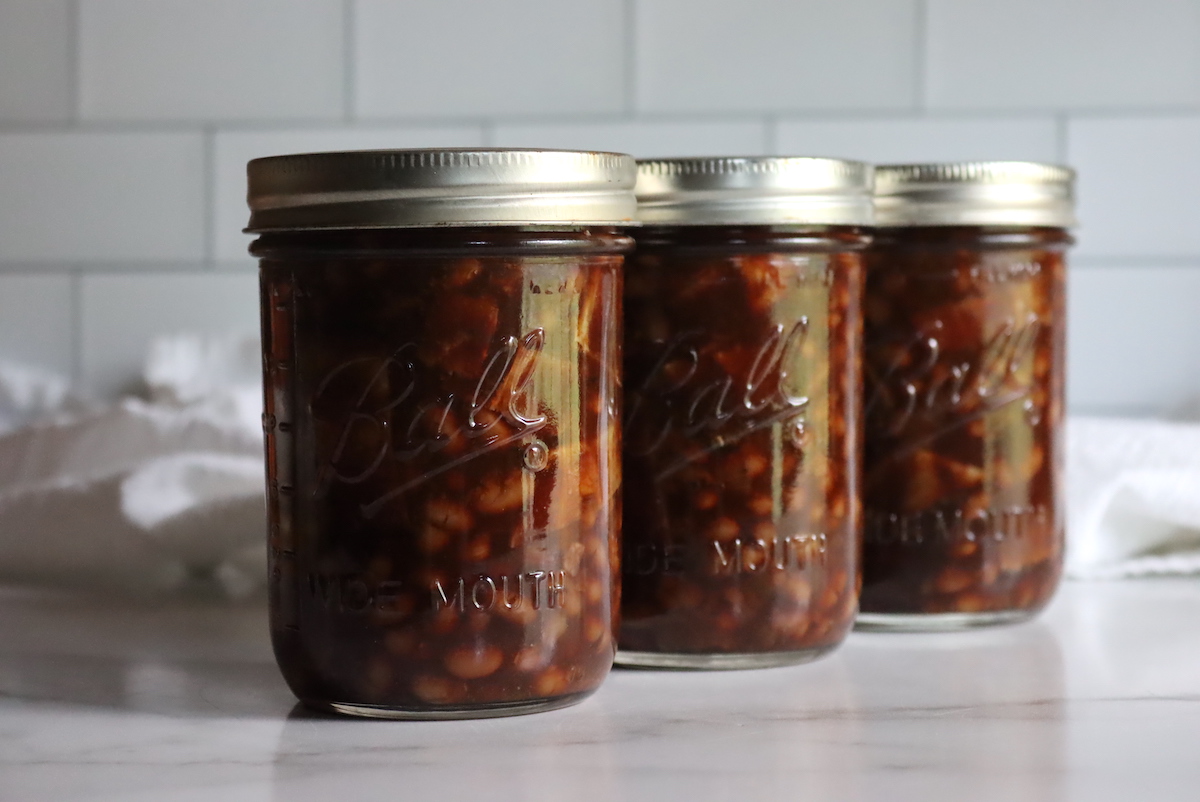
Soup Canning Recipes
Canning soup at home is such an easy way to put a meal in a jar, and I actually have a whole separate article covering soup canning recipes.
Here are some of the very best options:
- French Onion Soup
- Classic Beef Stew
- Vegetable Beef Stew
- Sausage, Kale, and White Bean Soup (Olive Garden Zuppa Toscana Copycat Recipe)
- Split Pea Soup with Ham
- Classic Chicken Soup
- Chicken Vegetable Soup
- Mexican Chicken Soup
- Chicken Tortilla Soup
- Sausage and Bean Soup
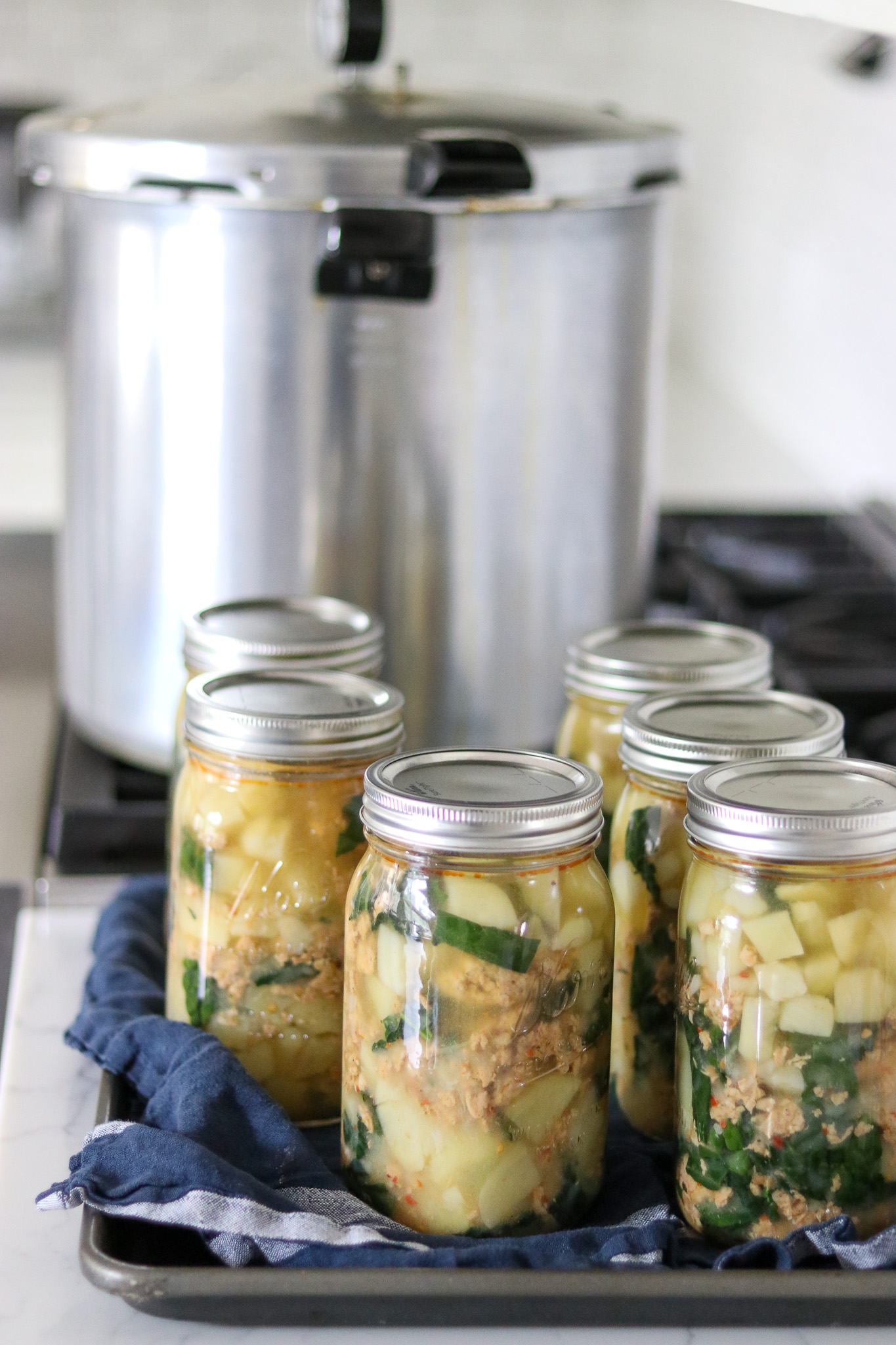
Other Meal in-a-Jar Ideas
Beyond explicit “meal in a jar” recipes, there are several other canning recipes that already make up most of a meal. Things like ready-made pasta sauce, especially pasta sauce with meat, only require cooking some pasta on the side.
These are almost a full meal and worth keeping on your pantry shelf.
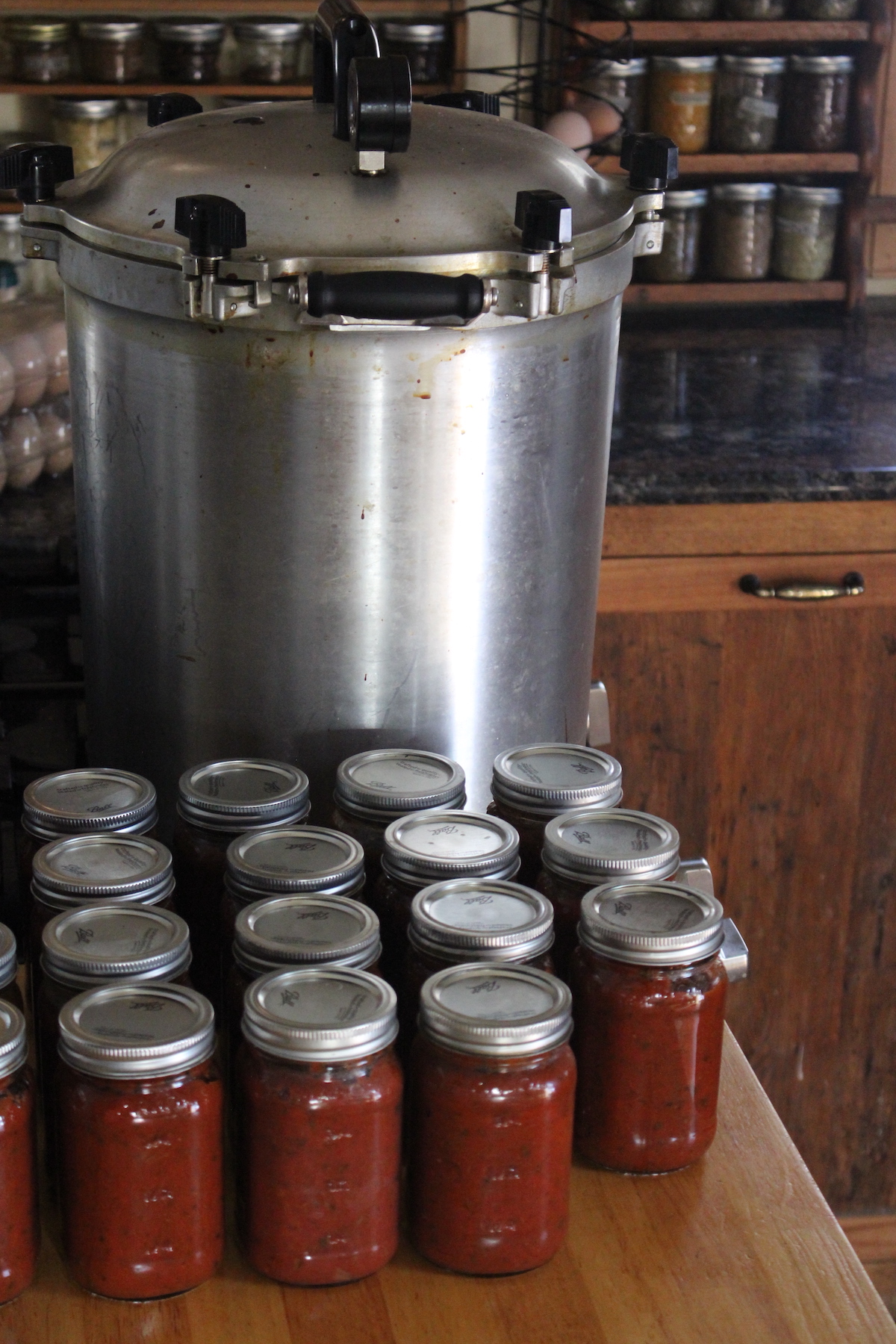
Canning Recipe Guides
Looking for delicious home canning recipes to stock your pantry?
- 100+ Canning Recipes from A to Z
- 50+ Pressure Canning Recipes
- 50+ Vegetable Canning Recipes
- How to Make Jam (with 30+ Recipes)
- 50+ Fruit Canning Recipes
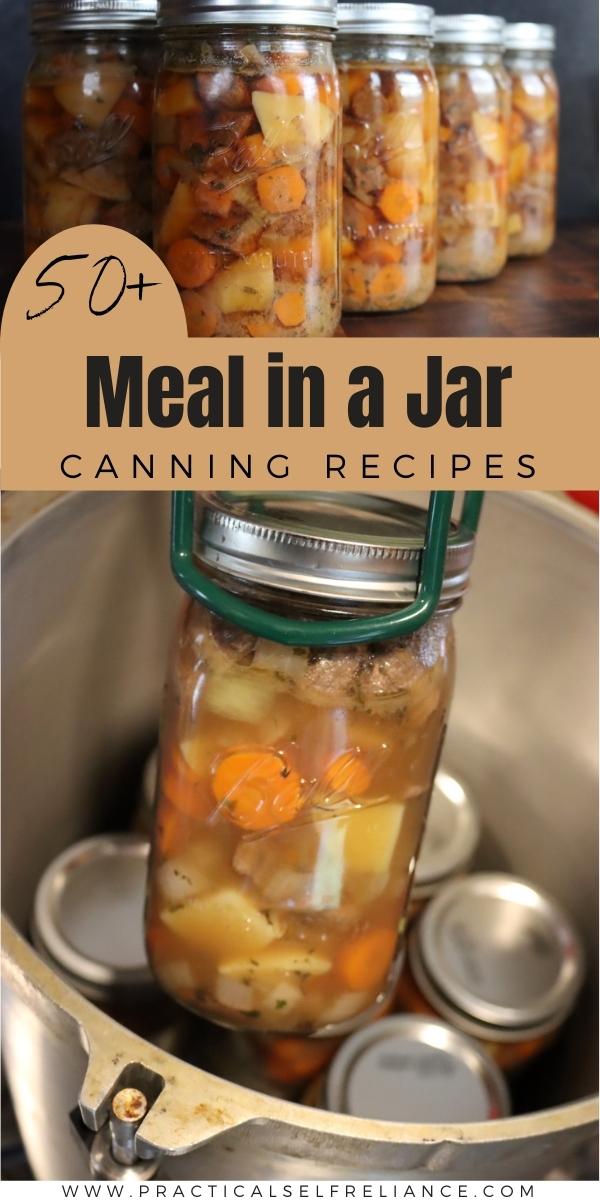
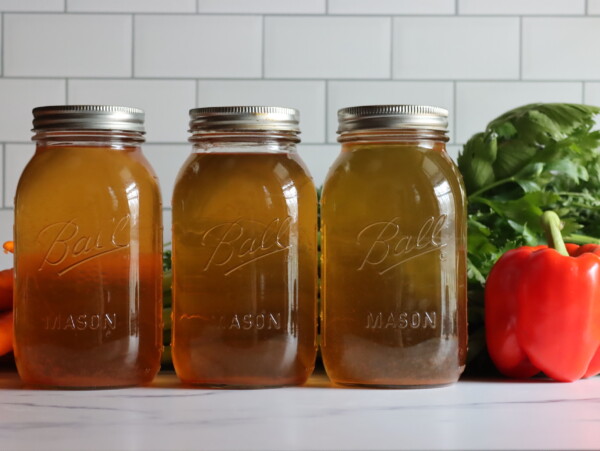
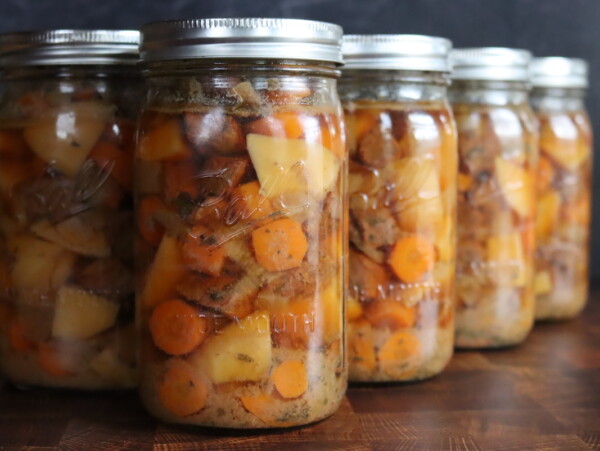
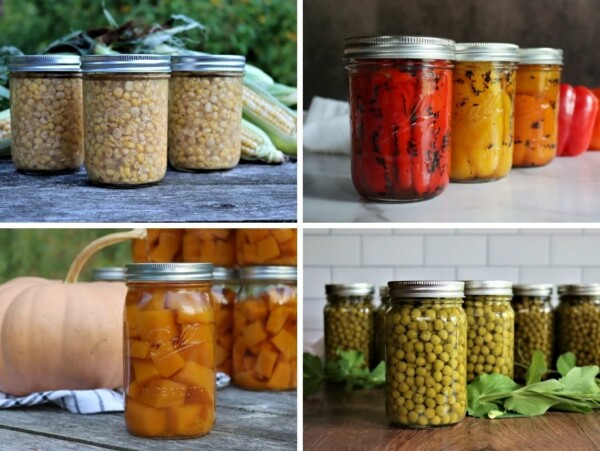
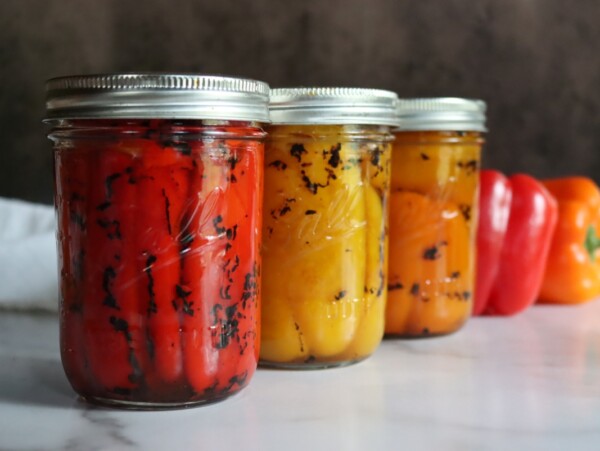










I’m curious what to do, some recipes call for celery and others peppers, but I can’t eat them. If I just leave them out of the recipe will that affect the safety of canning?
If so, what would be my best option?
Celery and peppers can be safely left out of any pressure canning recipe, no worries. Depending on how many are used, you may need to add more water to ensure the jars are full to the proper headspace, but beyond that, there’s no meal in a jar or soup canning recipe that will be adversely affected by skipping celery or peppers (at least in terms of safety). Personally, I really can’t stand celery, and I often leave it out, and my son doesn’t like peppers, so I sometimes skip that one too.
That is not true of all veggies, and in some recipes the tomatoes or tomatillos are required for acidity and safe canning. Peppers, celery and onions are never strictly required and can always be skipped to taste. Enjoy!
Hi, maybe I didn’t look fair enough, but I search pretty good. I could find no recipe to Cian fish.
The recipe has found elsewhere, only say, trout salmon, and fatty fish.
I’m don’t think whitefish and pollock fall into that category.
Any suggestions would be helpful as I have about £30 of white fish and or Pollock
Thank you again for all you do for us.
Hi Ann-Marie, I did a bit of research and it looks like from what I can tell, pollock isn’t treated differently than fatty fish. There’s a research paper here that tested various methods in the early 80’s: https://repository.library.noaa.gov/view/noaa/40446/noaa_40446_DS1.pdf
It has shorter process times than are currently recommended for fish, as more recent testing determined that fish needed more time. In a nutshell though, it looks like that paper is advocating for canning pollock as you would fatty fish (100 minutes at pressure), but simply adding a neutral oil to the jars (ie. 1 Tbsp per half pint), along with salt (1/2 tsp per half pint). If you want to remove the bones, they suggest steaming the fish, then cooling and hand removing bones before packing into jars. Unlike other fish, it sounds like pollock bones don’t break down in canning and are undesirable in jars.
This is my best read of guidance for canning white fish, but I encourage you to do your own research as there is no specifically tested modern method from the NCHFP, so it’s at your own risk. Best of luck!
This post is a treasure trove of ideas! I love the concept of Meal in a Jar for easy meals on busy days. The variety of recipes you provided is impressive, and I can’t wait to try the chili and chicken soup recipes. Thanks for sharing such practical and delicious options for canning!
You’re very welcome. We’re so glad it was helpful.
Do you sale this in a book format? Am I missing the link? Thanks
No I’m sorry we don’t currently have any books.
I have been canning tomatoe soup for years. I got the recipe from an 1977 Kerr canning book.
It has flour and butter in it.
I see you mention not to can with flour. Do you think this is an exception because it is in tomato?
This is our favorite tomato soup.
It is hot water bath.
No, unfortunately I think it is because the book was written before new research was done on canning guidelines. What I would do is can the recipe without the flour and butter. Then, when you get ready to prepare it you can make a roux with the butter and flour and then add the canned soup to the roux.
Could you share which of these recipes you’ve made and enjoyed?
Thanks for all of the helpful info!
This list was mainly created from research as to what was available on the internet. If you want a recommendation for solid recipes, I would definitely take the suggestion of getting Angi’s book that’s mentioned in the post.
How come your jars of product are so full? when headspace is needed. Have they just been mocked up for the photo shoot?
A 1 inch headspace is required for most pressured canned food which allows for the food to expand during the processing time. Some of what you’re seeing in the pictures may be a result of the food expanding from the heat of the canning process.
I looked at your sauerbraten recipe and it says ‘cube the meat’ but no mention of the amount of meat to use for that recipe. Could you give me an idea of the best meat for canning. Thanks
This isn’t actually our recipe. It’s a link to another website. It looks like they used bottom round in this recipe. There isn’t a specific amount. You just fill a pint jar 3/4 of the way with the meat. You can then use as many jars as you need for the amount of meat that you have on hand.